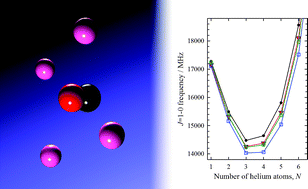Rotational study of carbon monoxide isotopologues in small 4Heclusters
Abstract
High resolution microwave (a-type) and millimetre-wave (b-type)

- This article is part of the themed collection: Chemical Dynamics of Large Amplitude Motion
* Corresponding authors
a
Department of Chemistry, University of Alberta, Edmonton, Alberta, Canada T6G 2G2
E-mail:
wolfgang.jaeger@ualberta.ca
b
I. Physikalisches Institut, University of Cologne, 50937 Cologne, Germany
E-mail:
schlemmer@ph1.uni-koeln.de
c Institute of Spectroscopy of RAS, 142190 Troitsk, Moscow Region, Russia
High resolution microwave (a-type) and millimetre-wave (b-type)

 Please wait while we load your content...
Something went wrong. Try again?
Please wait while we load your content...
Something went wrong. Try again?
P. L. Raston, Y. Xu, W. Jäger, A. V. Potapov, L. A. Surin, B. S. Dumesh and S. Schlemmer, Phys. Chem. Chem. Phys., 2010, 12, 8260 DOI: 10.1039/C0CP00193G
To request permission to reproduce material from this article, please go to the Copyright Clearance Center request page.
If you are an author contributing to an RSC publication, you do not need to request permission provided correct acknowledgement is given.
If you are the author of this article, you do not need to request permission to reproduce figures and diagrams provided correct acknowledgement is given. If you want to reproduce the whole article in a third-party publication (excluding your thesis/dissertation for which permission is not required) please go to the Copyright Clearance Center request page.
Read more about how to correctly acknowledge RSC content.
 Fetching data from CrossRef.
Fetching data from CrossRef.
This may take some time to load.
Loading related content
